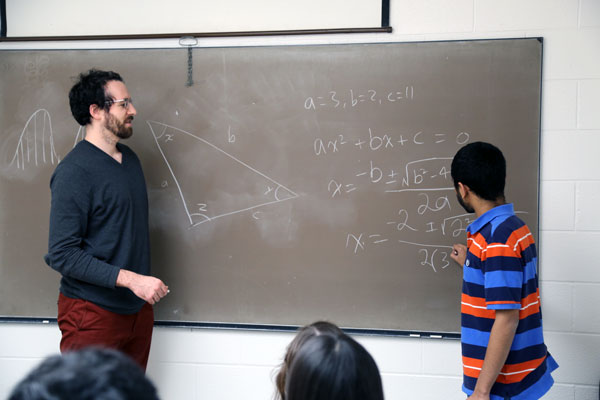
Justin Boutilier (MIE PhD candidate) and Ishraq Quayyum (Year 1 CompE) work on a quadratic equation. A new collaboration between graduate and undergraduate courses aims to apply engineering innovation to educational challenges. (Photo credit: Tyler Irving)
February 23, 2017 – An innovative collaboration between graduate and undergraduate students aims to leverage the engineering creative process to address educational challenges, from improving math instruction in high schools to easing anxiety among students transitioning to university.
“Engineers are fundamentally problem-solvers,” says Professor Chirag Variawa, (IndE 1T4) an expert on engineering education and the Faculty’s first Director, First-year Curriculum. “They look at the resources that are available and optimize them to come up with a solution. Education is, in many ways, just another context in which engineering can be performed.”
Variawa is a project manager for APS 112 Engineering Strategies and Practice II, a first-year course in which teams of undergraduate students from different disciplines work together on projects proposed by community partners. Past projects have included optimizing information management in hospitals and designing sustainability features for local buildings.
But Variawa realized that challenges in engineering education would also make good projects for the undergraduate teams to work on. For more input, he turned to students in another course he instructs: APS 1203/1204 Instructional Innovation in Engineering Education, which is aimed at graduate students who are part of the Prospective Professors in Training program or the Collaborative Program in Engineering Education.
“The graduate students see it as a mentoring/coaching enterprise where they get to apply what they are learning in class,” says Variawa. “The undergraduate students see it as an engineering design challenge, with the graduate students as the clients.”
Mechanical engineering PhD candidates Carmen Chui, Justin Boutilier and Bahar Memarian are working with a team of undergraduates to make mathematics instruction more stimulating and engaging for both students and teachers.
“I love math, and I want to change the negative associations that young people sometimes have, to show them how cool and interesting math can be,” says Boutilier.
How the undergraduate students might achieve their objective is still being discussed. “Their generation grew up with mobile technology, such as tablets and smartphones,” says Chui. “It would be interesting if they came up with an app, an electronic learning tool, or something activity-based such as a field trip.”
“It will be nice to see how bringing the real-world applications of mathematics into classrooms could impact student and teacher motivation,” add Memarian. “Students tend to enjoy working on projects and in labs. Mathematics could therefore be viewed and taught in a similar manner as other branches of sciences, such as physics.”
Other proposed challenges include a low-cost platform for teaching coding skills, addressing anxiety in the transition from high school to university and ensuring that students have the opportunity to learn from their mistakes.
“We’re leaving the design space open,” says Darlee Gerard, a PhD candidate in engineering education and the teaching assistant for APS 1203/4. “It could be an instructional intervention, an online learning tool, a training module or a reusable learning object.”
Though he admits it can be challenging to introduce a project like this for the first time, Variawa is optimistic about what the collaboration may spark. “A teacher is fundamentally a learner as well,” he says. “I love doing these kinds of experiments, and I wouldn’t be doing them if I didn’t think they could work.”
This story is the fourth in a five-part #RisingStars series on U of T Engineering News, highlighting the work of our early career professors.
